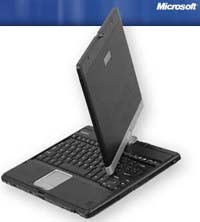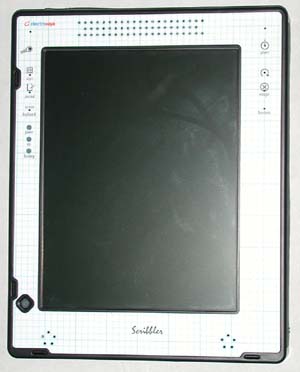Electrovaya Scribbler SC500 Tablet PC
by Matthew Witheiler on March 18, 2003 2:25 AM EST- Posted in
- Laptops
Construction - Build, Appearance, Size
Since our initial look at Microsoft's latest stab at an operating system, Microsoft Windows XP Tablet PC Edition, we have been getting quite a bit of feedback regarding the various tablet systems on the market. In our initial review we were limited to testing the operating system, applications, and features on an engineering sample of a yet to be produced tablet PC. Naturally we jumped upon the opportunity to review another tablet PC system. In this case the system we had the opportunity to evaluate is an Electrovaya Scribbler SC500.
You may recall that there are two types of tablet PCs on the market today. One type is the convertible tablet PC which resembles and opens like a standard notebook with a keyboard but can be rotated and folded in on itself to create a tablet system. The other type is called a slate tablet PC. Slate tablets combine a screen and system in one unit, requiring an external keyboard and mouse but gaining portability over convertible tablets. Like the FIC SlateVision, the Electrovaya Scribbler SC500 is a slate tablet PC. The system in no way resembles a conventional notebook computer and is devoid of an integrated touchpad, keyboard, optical drive, ect.
 |
 |
A
Convertible Tablet PC. |
A
Slate Tablet PC. |
As a slate tablet PC, the Scribbler SC500 resembles a notepad. Like the FIC SlateVision, the Scribbler SC500 is around the same size as a notepad although a significant amount thicker (than both a notepad and the SlateVision). This form factor in the area of width and length is fairly standard for slate tablet PCs as they aim to be as similar to the notepads they plan to replace as much as possible. Visually it seems that Electrovaya took this concept a bit too far. The front of the Scribbler SC500 is lined with a plastic sheet made to resemble graph paper resulting in what some have called a tacky appearance. Add to this the fact that the system is fairly bulky (not sleek like the SlateVision) and it becomes clear that the Scribbler series looks to be in the need of a redesign in a bad way.
Thankfully for Electrovaya in the world of computers looks are not everything. Appearance is important but clearly not as important as functionality, of which the SC500 has plenty of. Functionality starts with the front face of the SC500. Take the buttons on the front of the unit. Every slate type tablet PC certified by Microsoft must include a number of buttons that enable certain functions to be performed without a keyboard. Apart from the standard power button, slate tablet PCs must include a control-alt-delete button, a 5-way navigational button used for scrolling and navigating menus without a keyboard or stylus, and a button which can be used to rotate the display from portrait to landscape mode and back. The buttons on the SC500 are unique as they are not physically raised out of the unit's front. Instead the stylus is used to push pinhole style buttons (with the exception of the directional pad). At first we were not sure if we would like this method of input but after some use we found it to be very beneficial to the tablet PC's design. Instead of having to watch where our hands were placed to ensure that no buttons were pressed, our hands had free range over the front of the Scribbler SC500's surface.
There is certainly no shortage of pinhole buttons on the front of the system either. The text orientation on the front of the unit suggest that it is to be used in portrait mode and therefore we will be referring to positions with the tablet orientated in the portrait manner. On the left side of the unit are four buttons: one used to lock the computer while in Windows XP (the key button), one to execute the start button (the button labeled "start"), one to launch Windows XP Tablet PC Edition's built in Journal application (the button labeled "journal"), and one to bring up the OS' on screen keyboard (labeled "screen keyboard").

Also on the left side of the screen is the 5-way directional pad. Obviously the small rubber bit can be moved either up, down, left, or right. The fifth function of the pad comes when the bit is pressed down. Doing this is the same as hitting the enter key. The device feels like the pointing sticks found on some laptops except with more tactile feedback. We found the button was a bit small for our liking as it was hard to ensure that the button was being pressed up and not to the left or right.
The remaining push pin buttons are found on the right side of the system. Located here is the power button (labeled "power"), the screen rotation button (a counterclockwise circle), the escape button (labeled escape), and the function button (labeled "function"). The buttons should be self explanatory with the exception of the function button. This is the first tablet we have seen with a function button and, as we will get to in the software portion of the review, the button proves to be a useful addition. Again, we found this button style very easy to use. Since screen input is only recorded using the tablet's pen (remember, the screen is electrostatic, not touch sensitive) you will likely never find yourself without the tools to access the pinhole buttons.

There are also a set of three LED lights located on the left side of the system below the buttons but above the direction pad. These LEDs indicate power state (green while on), hard drive status (lit when the hard drive is being accessed), and battery status (orange while charging or on battery, green while charged).

The buttons and LEDs surround a 10.4" XGA LCD display that runs at 16-bit color. The screen, which is electro magnetic according to the Microsoft Tablet PC specification, appears to be the same screen used in the FIC SlateVision. The screens have similar appearances although the Scribbler SC500's screen did appear brighter than that of the pre-production SlateVision we looked at previously. Although we cannot know for certain that the 10.4" display in the Scribbler SC500 is the same as that used in the SlateVision, we do know that the digitizer units used in both are the same; something we will examine more once we take the unit apart. For now just keep in mind that the screen is not touch sensitive: the included pen does not actually have to make contact with the screen to move the cursor (for more information on the digitizer technology, read here).
Like other tablet PCs we have seen, the surface of the screen is covered with a protective layer of glass. This makes the screen much more resistant to cracking than the LCD panels found on most laptops (plus it prevents the LCD from generating false colors under acute pressure) and much more resistant to scratching than screens on PDAs (which have a very thin layer of plastic on top of them to make them touch sensitive). The protective layer on the SC500 felt slightly smoother than that on the SlateVision which is actually not as desirable as it makes writing on the tablet more like writing on glass than on paper. The pen did not glide aimless around the screen but tactile response could be improved by adding some texture to the screen surface while at the same time not sacrificing visibility.
We were pleased to find that the Scribbler SC500 includes two speakers, a left speaker and a right speaker. The speakers are located on the bottom of the system while in portrait mode. In this location the speakers were not easily obstructed by the placement of our hands, although they occasionally did get in the way while in landscape mode.
The line of holes on the top of the system are actually cooling vents. Like the SlateVision the Scribbler SC500 is passively cooled so no air is blown into our out of these holes. The small single hole on the left side of the unit which resembles a push pin button is actually the internal system microphone. Like the speakers, the position of the microphone was ideal for use in portrait mode but has the potential to be covered by a hand while in landscape mode.











1 Comments
View All Comments
Poopship - Tuesday, December 18, 2012 - link
I asked for an ipad and this is what I got